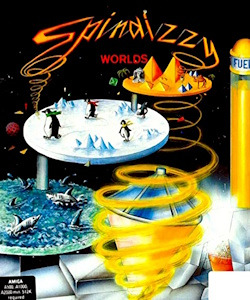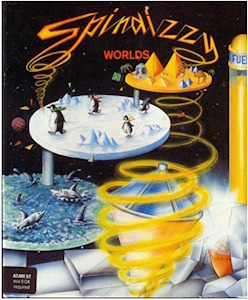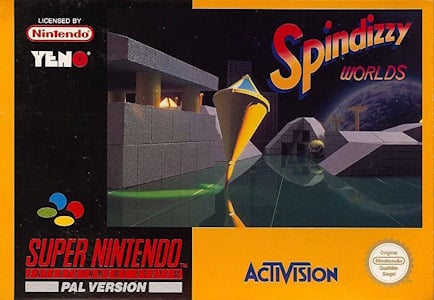Spindizzy Worlds (1990-)
Spindizzy Worlds was developed by Binary Emotions and released in 1990 for the Amiga and Atari ST, with a later port to the Super Nintendo Entertainment System (SNES) in 1992. The game was published by Electric Dreams Software on home computers and by ASCII Entertainment for the SNES version. It was a sequel to the 1986 isometric puzzle game Spindizzy, originally developed by Paul Shirley and published by Electric Dreams. While retaining the core concept of guiding a gyroscopic craft through floating landscapes, Spindizzy Worlds expanded on its predecessor with new levels, improved visuals, and more elaborate gameplay mechanics.
The game tasks the player with piloting a small, spinning craft named GERALD (Geographical Environmental Reconnaissance Landmapping Device) across a series of floating platforms in space. The objective is to explore these surreal, suspended worlds, collect energy, and solve navigational challenges while avoiding hazards and staying within the time limit. The game’s isometric perspective combined with precise, physics-based controls made it a test of both dexterity and spatial awareness. The difficulty ramps up gradually, requiring players to master the subtle movement of GERALD to progress.
The soundtrack on the Amiga and Atari ST versions consisted of bright, melodic tunes that suited the light-hearted yet challenging nature of the gameplay, accompanied by simple sound effects for movement and collisions. The SNES version introduced slightly richer audio, taking advantage of the console’s sound capabilities. As a sequel, Spindizzy Worlds benefited from the cult reputation of the original Spindizzy, with promotion in gaming magazines often highlighting its refined graphics, smoother scrolling, and more accessible level progression.
Reception for Spindizzy Worlds was positive among critics who appreciated its unique isometric design, addictive gameplay loop, and skill-based challenges. While some noted its steep learning curve, fans praised its inventive puzzles and satisfying sense of mastery. Though it never achieved mass-market fame, it retained a loyal following and is often remembered fondly as a challenging but rewarding title from the golden age of 16-bit puzzle-action games.
Features:
Sequel to the cult 1986 game Spindizzy
Control the gyroscopic craft GERALD through isometric 3D worlds
Multiple themed floating landscapes to explore
Physics-based movement requiring precision and control
Timed missions with increasing difficulty
Released on Amiga, Atari ST, and SNES with graphical and audio enhancements
Images from MobyGames
Buy Spindizzy Worlds
Click one of the Ebay or Amazon buttons below to check the latest prices and purchase Spindizzy Worlds for that particular platform.



Related Searches
Spindizzy Worlds is available to purchase and download from a range of vendors. Always shop....
Spindizzy Worlds may be available to download as abandonware from one of the many sites that offer this...
There are various sites out there that can offer cheat codes for games. Search now to find all available...
There are many sites out there that have collated and documented historic reviews of this game. Search now...
We don't host or link to rom sites for this game. However, there are many sites out there that may be...
The initial release date for Spindizzy Worlds is stated as some time during 1990. Other ports of the game may....
Spindizzy Worlds is available to purchase and download from the link(s) shown further up this....
There are multiple sites around the internet that offer visual guides to this game. Search now to find the....








